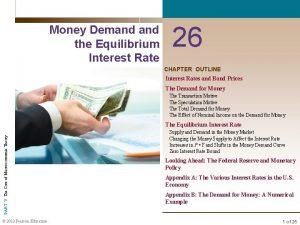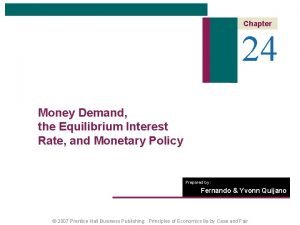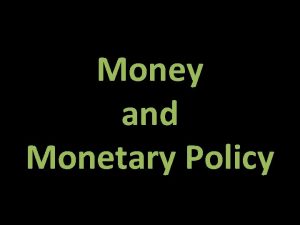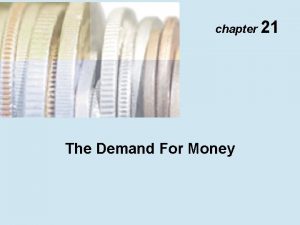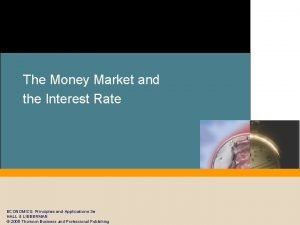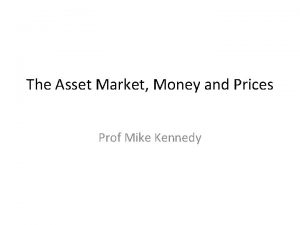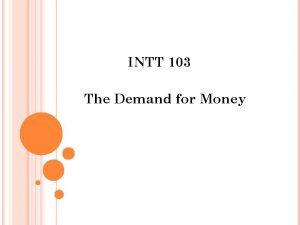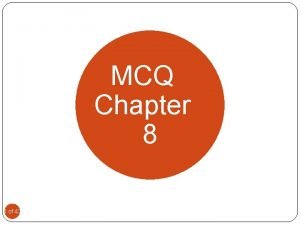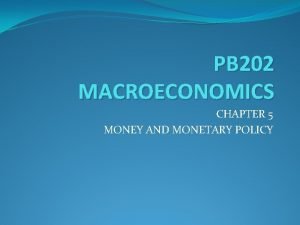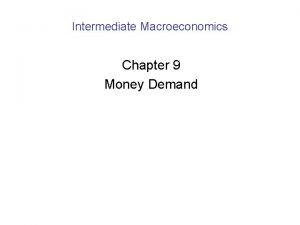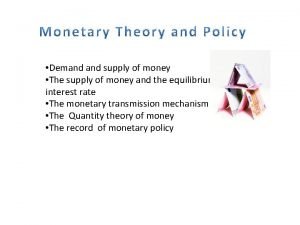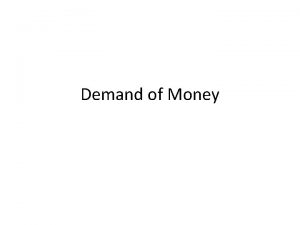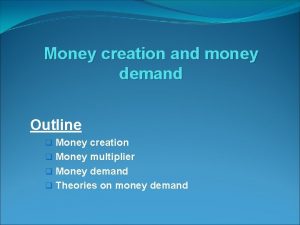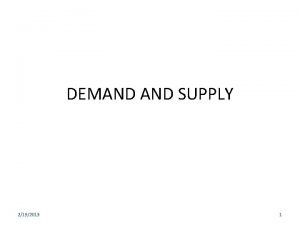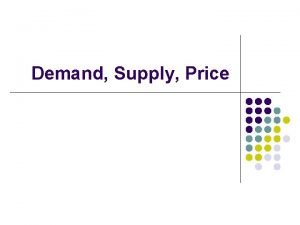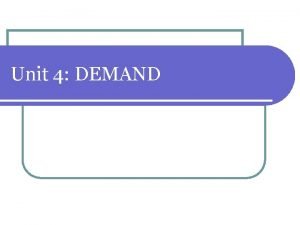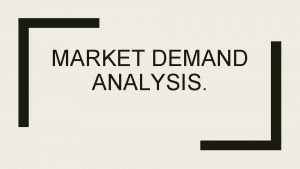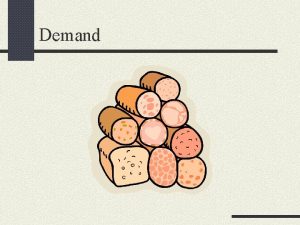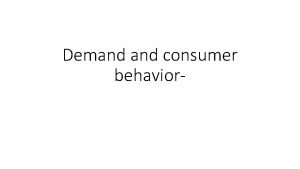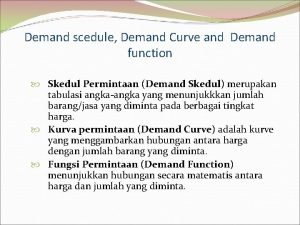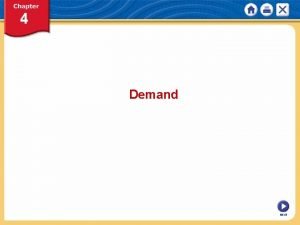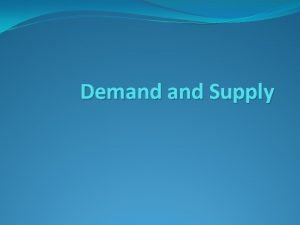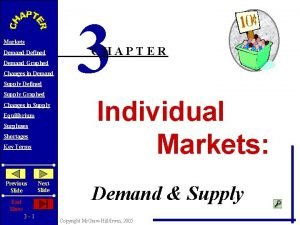The Demand for Money Demand for money How



























































- Slides: 59

The Demand for Money • Demand for money • How much money people would like to hold, given the constraints that they face • NOT: how much money people would like to have in the best of all possible worlds © 2010 Cengage Learning. All Rights Reserved. May not be scanned, copied or duplicated, or posted to a publicly accessible Web site, in whole or in part. 1

A Household’s Demand for Money • An individual’s wealth constraint • At any point in time, total wealth is fixed • You must give up one kind of wealth in order to acquire more of another • An household’s quantity of money demanded • Amount of wealth that the household chooses to hold as money, rather than as other assets © 2010 Cengage Learning. All Rights Reserved. May not be scanned, copied or duplicated, or posted to a publicly accessible Web site, in whole or in part. 2

A Household’s Demand for Money • Households choose how to divide wealth between two assets • Money • Can be used as a means of payment • Earns no interest • Bonds • Earn interest • Cannot be used as a means of payment © 2010 Cengage Learning. All Rights Reserved. May not be scanned, copied or duplicated, or posted to a publicly accessible Web site, in whole or in part. 3

A Household’s Demand for Money • Opportunity cost of holding money • Interest you could have earned by holding other assets instead • Tradeoff: The more wealth we hold as money • The less often we will have to go through the inconvenience of changing our bonds into money • And the less interest we will earn on our wealth © 2010 Cengage Learning. All Rights Reserved. May not be scanned, copied or duplicated, or posted to a publicly accessible Web site, in whole or in part. 4

A Household’s Demand for Money • Choose the amount of money to hold: • = Quantity demanded of money • A rise in price level • Hold more money • A rise in real income • Hold more money • A higher interest rate • Hold less money © 2010 Cengage Learning. All Rights Reserved. May not be scanned, copied or duplicated, or posted to a publicly accessible Web site, in whole or in part. 5

The Demand for Money by Businesses • Quantity demanded of money – is greater: • The higher price level • The higher real income • The lower interest rate • Constraints: • Given wealth • How much wealth to hold as money rather than other assets (“bonds”) © 2010 Cengage Learning. All Rights Reserved. May not be scanned, copied or duplicated, or posted to a publicly accessible Web site, in whole or in part. 6

The Economy-wide Demand for Money • Economy-wide quantity of money demanded • The amount of total wealth in the economy • That all households and businesses, together, choose to hold as money rather than as bonds • Quantity of money demanded in the economy is greater: • The higher the price level • The higher the real income • The lower the interest rate © 2010 Cengage Learning. All Rights Reserved. May not be scanned, copied or duplicated, or posted to a publicly accessible Web site, in whole or in part. 7

The Demand for Money • Money demand curve • Total quantity of money demanded • At each interest rate • Change in interest rate • Move along the money demand curve © 2010 Cengage Learning. All Rights Reserved. May not be scanned, copied or duplicated, or posted to a publicly accessible Web site, in whole or in part. 8

Figure 1: The Money Demand Curve Interest Rate The money demand curve is drawn for a given real GDP and a given price level. At an interest rate of 6 percent, $1, 000 billion of money is demanded. 6% E If the interest rate drops to 3 percent, the quantity of money demanded increases to $1, 600 billion. F 3% Md 1, 000 1, 600 Money ($ billions) © 2010 Cengage Learning. All Rights Reserved. May not be scanned, copied or duplicated, or posted to a publicly accessible Web site, in whole or in part. 9

The Demand for Money • Shifts in the money demand curve • Change in money demand caused by something other than the interest rate • Real income • Price level © 2010 Cengage Learning. All Rights Reserved. May not be scanned, copied or duplicated, or posted to a publicly accessible Web site, in whole or in part. 10

Figure 2: A Shift in the Money Demand Curve Interest Rate An increase in real GDP or in the price level will shift the money demand curve rightward. At any interest rate, more money will be demanded after the shift. 6% E G H F 3% M 2 d M 1 d 1, 000 1, 400 1, 600 2, 000 Money ($ billions) © 2010 Cengage Learning. All Rights Reserved. May not be scanned, copied or duplicated, or posted to a publicly accessible Web site, in whole or in part. 11

Figure 3: Shifts and movements along the money demand curve: A summary Interest Rate Interest rate ↑ moves us leftward along the money demand curve. 9% C A 6% Interest rate ↓ moves us rightward along the money demand curve. B 3% M 2 d M 1 d 600 1, 000 1, 600 Entire money demand curve shifts rightward if the price level or income increases. Money ($ billions) M 1 d Money ($ billions) © 2010 Cengage Learning. All Rights Reserved. May not be scanned, copied or duplicated, or posted to a publicly accessible Web site, in whole or in part. 12

The Supply of Money • Money supply curve • Total quantity of money in the economy at each interest rate • Straight vertical line • Determined by the Fed • Shift in money supply • The Fed changes the money supply © 2010 Cengage Learning. All Rights Reserved. May not be scanned, copied or duplicated, or posted to a publicly accessible Web site, in whole or in part. 13

Figure 4: The supply of money Interest Rate M 1 S Once the Fed sets the money supply, it remains constant until the Fed changes it. The vertical supply curve labeled M 1 S shows a money supply of $1, 000 billion, regardless of the interest rate. An increase in the money supply to $1, 400 billion is depicted as a rightward shift of the money supply curve to M 2 S 6% E 3% J 1, 000 1, 400 Money ($ billions) © 2010 Cengage Learning. All Rights Reserved. May not be scanned, copied or duplicated, or posted to a publicly accessible Web site, in whole or in part. 14

The Supply of Money • Open market purchases of bonds • Inject reserves into the banking system • Shift the money supply curve rightward • By a multiple of the reserve injection • Open market sales • Withdraw reserves from the system • Shift the money supply curve leftward • By a multiple of the reserve withdrawal © 2010 Cengage Learning. All Rights Reserved. May not be scanned, copied or duplicated, or posted to a publicly accessible Web site, in whole or in part. 15

Equilibrium in the Money Market • Interest rate, long run • Determined by equilibrium in the loanable funds market • A flow of loanable funds is offered by lenders to borrowers © 2010 Cengage Learning. All Rights Reserved. May not be scanned, copied or duplicated, or posted to a publicly accessible Web site, in whole or in part. 16

Equilibrium in the Money Market • Interest rate, short run • Equilibrium interest rate in the money market • Quantity of money demanded = quantity of money supplied • Equilibrium in the money market • When the quantity of money people are actually holding (quantity supplied) • Is equal to the quantity of money they want to hold (quantity demanded) © 2010 Cengage Learning. All Rights Reserved. May not be scanned, copied or duplicated, or posted to a publicly accessible Web site, in whole or in part. 17

Figure 5: Money Market Equilibrium Interest Rate MS At a higher interest rate, an excess supply of money causes the interest rate to fall. 9% At the equilibrium interest rate of 6%, the public is content to hold the quantity of money it is actually holding. E 6% At a lower interest rate, an excess demand for money causes the interest rate to rise. 3% Md 600 1, 000 1, 600 Money ($ billions) © 2010 Cengage Learning. All Rights Reserved. May not be scanned, copied or duplicated, or posted to a publicly accessible Web site, in whole or in part. 18

Equilibrium in the Money Market • If interest rate > equilibrium • Excess supply of money • Excess demand for bonds • Excess supply of money • Amount of money supplied > amount demanded at a particular interest rate © 2010 Cengage Learning. All Rights Reserved. May not be scanned, copied or duplicated, or posted to a publicly accessible Web site, in whole or in part. 19

Equilibrium in the Money Market • Excess demand for bonds • Amount of bonds demanded > amount supplied at a particular interest rate © 2010 Cengage Learning. All Rights Reserved. May not be scanned, copied or duplicated, or posted to a publicly accessible Web site, in whole or in part. 20

Equilibrium in the Money Market • When the price of bonds rises • The interest rate falls • When the price of bonds falls • The interest rate rises © 2010 Cengage Learning. All Rights Reserved. May not be scanned, copied or duplicated, or posted to a publicly accessible Web site, in whole or in part. 21

Equilibrium in the Money Market • Interest rate • In the long run - determined in the market for loanable funds • Household saving is lent to businesses and the government • In the short run - determined in the money market • Wealth holders adjust their wealth between money and bonds • The Fed – can change the money supply © 2010 Cengage Learning. All Rights Reserved. May not be scanned, copied or duplicated, or posted to a publicly accessible Web site, in whole or in part. 22

What Happens When Things Change? • The Fed wants to lower the interest rate • Increase the money supply • Buy government bonds © 2010 Cengage Learning. All Rights Reserved. May not be scanned, copied or duplicated, or posted to a publicly accessible Web site, in whole or in part. 23

What Happens When Things Change? • The Fed wants to increase the interest rate • Decrease the money supply • Sell government bonds © 2010 Cengage Learning. All Rights Reserved. May not be scanned, copied or duplicated, or posted to a publicly accessible Web site, in whole or in part. 24

Figure 6: An Increase in the Money Supply At point E, the money market is in Interest equilibrium at an interest rate of 6 percent. Rate To lower the interest rate, the M 1 S M 2 S Fed could increase the money supply to $1, 600 billion. 6% The excess supply of money (and excess demand for bonds) would cause bond prices to rise, and the interest rate to fall, until a new equilibrium is established at point F with an interest rate of 3 percent. E F 3% Md 1, 000 1, 600 Money ($ billions) © 2010 Cengage Learning. All Rights Reserved. May not be scanned, copied or duplicated, or posted to a publicly accessible Web site, in whole or in part. 25

What Happens When Things Change? • Interest rate falls • Increased spending on: • Plant and equipment • New housing • Consumer durables (especially automobiles) • Interest rate rises • Decreased spending on: • Plant and equipment, New housing • Consumer durables (especially automobiles) © 2010 Cengage Learning. All Rights Reserved. May not be scanned, copied or duplicated, or posted to a publicly accessible Web site, in whole or in part. 26

Monetary Policy • Monetary policy • Control or manipulation of interest rates by the Federal Reserve • Designed to achieve a macroeconomic goal • Fed - open market purchases of bonds: © 2010 Cengage Learning. All Rights Reserved. May not be scanned, copied or duplicated, or posted to a publicly accessible Web site, in whole or in part. 27

Figure 7: Monetary Policy and the Economy Real Aggregate Expenditure ($ billions) Interest Rate M 1 S M 2 S F 6% A AEr=6% E B 3% Md 1, 000 AEr=3% 1, 600 Money ($ billions) 45° 8, 000 10, 000 Real GDP ($ billions) Initially, the Fed has set the money supply at $1, 000 billion, so the interest rate is 6% (point A). Given that interest rate, aggregate expenditure is AEr=6% in panel (b), and real GDP is $8, 000 billion (point E). If the Fed increases the money supply to $1, 600 billion, money market equilibrium moves to B in panel (a). The interest rate falls to 3% (point B), stimulating interest-sensitive spending and driving aggregate expenditures upward in panel (b). Through the multiplier process, real GDP increases to $10, 000 billion (point F). © 2010 Cengage Learning. All Rights Reserved. May not be scanned, copied or duplicated, or posted to a publicly accessible Web site, in whole or in part. 28

Monetary Policy • Fed - open market sale of bonds: © 2010 Cengage Learning. All Rights Reserved. May not be scanned, copied or duplicated, or posted to a publicly accessible Web site, in whole or in part. 29

Monetary Policy • Fed – maintain an interest rate target: • To prevent fluctuations in money demand from affecting the economy • The Fed adjusts the money supply to maintain its interest rate target © 2010 Cengage Learning. All Rights Reserved. May not be scanned, copied or duplicated, or posted to a publicly accessible Web site, in whole or in part. 30

Figure 8: Maintaining an Interest Rate Target Real Aggregate Expenditure ($ billions) Interest Rate M 1 S 8% 5% M 2 S B A AEr=5% C M 2 d M 1 d 1, 000 1, 400 Money ($ billions) 45° 10, 000 YFE Real GDP ($ billions) Initially, the money market in panel (a) is at point A, with the interest rate at its target of 5%. In panel (b), this interest rate positions the AE line to create equilibrium output of $10, 000 billion, which results in full employment. An increase in money demand from M 1 d to M 2 d in panel (a), with no action by the Fed, would drive the interest rate up to 8%, and shift the AE line in panel (b) downward. To prevent this, the Fed increases the money supply from $1, 000 billion ( M 1 S) to $1, 400 billion ( M 2 S), moving the money market equilibrium to point C. This maintains the interest rate at its target of 5%, and prevents any change in equilibrium output in panel (b). © 2010 Cengage Learning. All Rights Reserved. May not be scanned, copied or duplicated, or posted to a publicly accessible Web site, in whole or in part. 31

Monetary Policy • Fed – change the interest rate target: • To prevent or address unwanted changes in aggregate expenditure • The Fed changes its interest rate target, adjusting the money supply as needed to reach it © 2010 Cengage Learning. All Rights Reserved. May not be scanned, copied or duplicated, or posted to a publicly accessible Web site, in whole or in part. 32

Figure 9: Changing the Interest Rate Target to Prevent a Recession Real Aggregate Expenditure ($ billions) Interest Rate M 1 S M 2 S E AE 1 AE 2 5% A F C 3% Md 1, 000 1, 300 Money ($ billions) 45° 9, 000 10, 000 Real GDP ($ billions) Initially, the money market in panel (a) is at point A, with the interest rate at its target of 5%. In panel (b), equilibrium output is $10, 000 billion, which is the full-employment output level. Then, in panel (b), the AE line shifts downward because of a decrease in some sector’s spending. With no change in Fed policy, output would fall from $10, 000 billion to $9, 000 billion (point F). To prevent this recession, the Fed lowers its interest rate target to 3% in panel (a), and increases the money supply from $1, 000 billion ( M 1 S) to 1, 300 billion (M 2 S). This moves the money market equilibrium to point C. The lower interest rate raises consumption and investment spending, shifting the AE line in panel (b) back to its original position. © 2010 Cengage Learning. All Rights Reserved. May not be scanned, copied or duplicated, or posted to a publicly accessible Web site, in whole or in part. 33

Monetary Policy with Many Interest Rates • Federal funds market • Banks with excess reserves lend them out to other banks • For very short periods, usually a day • Interest rate = federal funds rate © 2010 Cengage Learning. All Rights Reserved. May not be scanned, copied or duplicated, or posted to a publicly accessible Web site, in whole or in part. 34

Monetary Policy with Many Interest Rates • Federal funds rate • The interest rate charged for loans of reserves among banks • Targeted by the Fed • New tool: interest on reserves • Interest rate for reserves sets a floor for the federal funds rate © 2010 Cengage Learning. All Rights Reserved. May not be scanned, copied or duplicated, or posted to a publicly accessible Web site, in whole or in part. 35

Unconventional Monetary Policy • The Fed – unconventional tools in case of: • Changing interest rate spreads • The zero lower bound • Financial crises • Interest rate spread • The difference between any particular interest rate and a benchmark interest rate © 2010 Cengage Learning. All Rights Reserved. May not be scanned, copied or duplicated, or posted to a publicly accessible Web site, in whole or in part. 36

Unconventional Monetary Policy • Changing interest rate spreads • The Fed cannot use federal funds rate • The Fed can change spreads by arranging the buying or selling of assets other than government bonds • Economic and political costs © 2010 Cengage Learning. All Rights Reserved. May not be scanned, copied or duplicated, or posted to a publicly accessible Web site, in whole or in part. 37

Unconventional Monetary Policy • Zero lower bound • Federal funds rate – could reach zero • The Fed can reduce the real rate as low as it wants by increasing expected inflation • Uncertain effects on long-term real interest rates • Can leave the economy with a difficult-tosolve inflation problem © 2010 Cengage Learning. All Rights Reserved. May not be scanned, copied or duplicated, or posted to a publicly accessible Web site, in whole or in part. 38

Unconventional Monetary Policy • Financial crises • Conventional features – for banks • Deposit insurance • The discount window • Expand extend these features to nonbanks © 2010 Cengage Learning. All Rights Reserved. May not be scanned, copied or duplicated, or posted to a publicly accessible Web site, in whole or in part. 39

The Fed and the financial crisis of 2008 • Conventional tools in 2007 and early 2008 • Lower federal funds target, September 2007 • Before the AE line began shifting downward • Continued to lower it for the next 15 months • Not enough to prevent a recession • Other interest rates in the economy remained stubbornly high © 2010 Cengage Learning. All Rights Reserved. May not be scanned, copied or duplicated, or posted to a publicly accessible Web site, in whole or in part. 40

Figure 10 a: The Fed in Action: 2001 © 2010 Cengage Learning. All Rights Reserved. May not be scanned, copied or duplicated, or posted to a publicly accessible Web site, in whole or in part. 41

Figure 10 b: The Fed in Action: 2001 © 2010 Cengage Learning. All Rights Reserved. May not be scanned, copied or duplicated, or posted to a publicly accessible Web site, in whole or in part. 42

Figure 10 c: The Fed in Action: 2001 © 2010 Cengage Learning. All Rights Reserved. May not be scanned, copied or duplicated, or posted to a publicly accessible Web site, in whole or in part. 43

The Fed and the financial crisis of 2008 • The need for unconventional tools • Rising spreads • Federal funds rate was fast approaching the zero lower bound • Financial crisis was worsening • How the Fed (and the Treasury) responded • Lender of last resort: easier for banks to borrow anonymously for short periods • Created incentives for other financial players to purchase mortgage-backed securities © 2010 Cengage Learning. All Rights Reserved. May not be scanned, copied or duplicated, or posted to a publicly accessible Web site, in whole or in part. 44

The Fed and the financial crisis of 2008 • How the Fed (and the Treasury) responded • Purchase $500 billion worth of mortgage backed securities • Later increasing the amount to more than $1 trillion • Assisted the Treasury as it lent out hundreds of billions of dollars to troubled financial institutions • Taking newly issued shares of stock as collateral. © 2010 Cengage Learning. All Rights Reserved. May not be scanned, copied or duplicated, or posted to a publicly accessible Web site, in whole or in part. 45

The Fed and the financial crisis of 2008 • The exit strategy • As it provided reserves to specific institutions or markets through most of 2008 • It simultaneously conducted open market sales to prevent the total amount of reserves from rising • Congress - granted the Fed immediate authority to pay interest on reserves © 2010 Cengage Learning. All Rights Reserved. May not be scanned, copied or duplicated, or posted to a publicly accessible Web site, in whole or in part. 46

Figure 11: The Fed acting as a financial intermediary © 2010 Cengage Learning. All Rights Reserved. May not be scanned, copied or duplicated, or posted to a publicly accessible Web site, in whole or in part. 47

Figure 12: Explosive growth in the total reserves of U. S. banks © 2010 Cengage Learning. All Rights Reserved. May not be scanned, copied or duplicated, or posted to a publicly accessible Web site, in whole or in part. 48

The Fed and the financial crisis of 2008 • The Controversies • Should have lowered the Federal funds rate more aggressively in late 2007 and throughout 2008 • Why it began paying significant interest on reserves so early • Encouraged banks to hold reserves during the crisis rather than create new loans • Could have done more to raise expected inflation • Lowered the real federal funds rate even after the nominal funds rate reached the zero lower bound © 2010 Cengage Learning. All Rights Reserved. May not be scanned, copied or duplicated, or posted to a publicly accessible Web site, in whole or in part. 49

The Fed and the financial crisis of 2008 • The Controversies • Over the Fed’s enlarged role in the economy • Some in Congress and the public - not happy • The Fed - imposing risks on taxpayers • To rescue the financial system itself and the owners and creditors of financial institutions © 2010 Cengage Learning. All Rights Reserved. May not be scanned, copied or duplicated, or posted to a publicly accessible Web site, in whole or in part. 50

The Fed and the financial crisis of 2008 • The Controversies • The Fed found itself in the center of a political firestorm • Expand the Fed’s regulatory powers • Shrink the Fed’s role and limit its powers • Greater disclosure about the details of Fed policy -making © 2010 Cengage Learning. All Rights Reserved. May not be scanned, copied or duplicated, or posted to a publicly accessible Web site, in whole or in part. 51

Click To Edit Feedback effects from GDP to the money market • Include feedback effects from income to the money market • A given change in the money supply • Will cause a smaller change in the interest rate • To achieve any given change in the interest rate • Requires a larger change in the money supply © 2010 Cengage Learning. All Rights Reserved. May not be scanned, copied or duplicated, or posted to a publicly accessible Web site, in whole or in part. 52

Figure A. 1: A More Complete View of Monetary Policy Interest Rate M 1 S Real Aggregate Expenditure ($ billions) M 2 S AEr=4. 5% H 6% A C 4. 5% 3% B 1, 000 AEr=6% 1, 600 E Md. Y=$9, 000 billion Md. Y=$8, 000 billion Money ($ billions) 45° 8, 000 9, 000 Real GDP ($ billions) Initially, the Fed has set the money supply at $1, 000 billion, so the interest rate is 6% (point A). Given that interest rate, the aggregate expenditure line is AEr=6% in panel (b), and real GDP is $8, 000 billion (point E). If the Fed increases the money supply to $1, 600 billion and the money demand curve did not shift (as in the chapter), the money market equilibrium moves temporarily to point B in panel (a). The interest rate falls, stimulating interest-sensitive spending and shifting up the aggregate expenditure line in panel (a). Through the multiplier expenditure, real GDP increases. The rise in GDP has feedback effects on the money market in panel (a): The money demand curve shifts rightward, because more money is demanded when income is greater. In the new equilibrium, real GDP is $9, 000 billion, and the interest rate is 4. 5% (point C). Because of the feedback effects from GDP to the money market, the interest rate drops less, and GDP rises less, than when these feedback effects are ignored. © 2010 Cengage Learning. All Rights Reserved. May not be scanned, copied or duplicated, or posted to a publicly accessible Web site, in whole or in part. 53

Click To Edit Feedback effects from GDP to the money market • Fiscal policy - increase in government purchases • Expenditure multiplier process • Increase GDP and income in each round • Shift AE line upward • As income increases • Money demand curve - shift rightward • Raising the interest rate • Autonomous consumption (a) and investment spending (I) will decrease • Shift AE line downward © 2010 Cengage Learning. All Rights Reserved. May not be scanned, copied or duplicated, or posted to a publicly accessible Web site, in whole or in part. 54

Click To Edit Feedback effects from GDP to the money market • Fiscal policy - increase in government purchases • In the short run • Causes real GDP to rise, but not by as much as if the interest rate had not increased © 2010 Cengage Learning. All Rights Reserved. May not be scanned, copied or duplicated, or posted to a publicly accessible Web site, in whole or in part. 55

Figure A. 2: Fiscal Policy and the Money Market Interest Rate Real Aggregate Expenditure ($ billions) MS F AEr=8% 8% B 6% A L Greater G AEr=6% E Md. Y=$9, 500 billion Md. Y=$8, 000 billion 1, 000 Money ($ billions) 45° 8, 000 9, 500 10, 500 Real GDP ($ billions) The economy is initially in equilibrium with an interest rate of 6 percent in panel (a) and real GDP of $8, 000 billion in panel (b). An increase in government purchases shifts the aggregate expenditure line upward, triggering the expenditure multiplier process. If the interest rate did not change, equilibrium would be reestablished at point F in panel (b) with real GDP of $10, 500 billion. But the increase in GDP increases money demand in panel (a), driving the interest rate upward to 8 percent at point B. That reduces interest-sensitive spending, lowering aggregate expenditure to AEr=8% in panel (b) so that the real GDP at the new equilibrium is $9, 500 billion (point L). © 2010 Cengage Learning. All Rights Reserved. May not be scanned, copied or duplicated, or posted to a publicly accessible Web site, in whole or in part. 56

Click To Edit Feedback effects from GDP to the money market • New equilibrium after an increase in government purchases: • AE line is higher • But by less than ΔG • Real GDP and real income are higher • But the rise is less than [1/(1—MPC)]ˣΔG. • Money demand curve has shifted rightward • Because real income is higher © 2010 Cengage Learning. All Rights Reserved. May not be scanned, copied or duplicated, or posted to a publicly accessible Web site, in whole or in part. 57

Click To Edit Feedback effects from GDP to the money market • New equilibrium after an increase in government purchases: • Interest rate is higher • Because money demand has increased. • Autonomous consumption and investment spending are lower • Because the interest rate is higher © 2010 Cengage Learning. All Rights Reserved. May not be scanned, copied or duplicated, or posted to a publicly accessible Web site, in whole or in part. 58

Click To Edit Feedback effects from GDP to the money market • Crowding out • Including the effects in the money market in the short-run macro model • An increase in government purchases • Raises the interest rate • Crowds out some private investment spending • May crowd out consumption spending © 2010 Cengage Learning. All Rights Reserved. May not be scanned, copied or duplicated, or posted to a publicly accessible Web site, in whole or in part. 59
 Money money money team
Money money money team Money smart money match
Money smart money match Money on money multiple
Money on money multiple The great gatsby historical context
The great gatsby historical context Old money aesthetic
Old money aesthetic How is daisy described in the great gatsby
How is daisy described in the great gatsby Các châu lục và đại dương trên thế giới
Các châu lục và đại dương trên thế giới Sơ đồ cơ thể người
Sơ đồ cơ thể người ưu thế lai là gì
ưu thế lai là gì Môn thể thao bắt đầu bằng chữ đua
Môn thể thao bắt đầu bằng chữ đua Tư thế ngồi viết
Tư thế ngồi viết Cái miệng nó xinh thế chỉ nói điều hay thôi
Cái miệng nó xinh thế chỉ nói điều hay thôi Hình ảnh bộ gõ cơ thể búng tay
Hình ảnh bộ gõ cơ thể búng tay Cách giải mật thư tọa độ
Cách giải mật thư tọa độ Tư thế ngồi viết
Tư thế ngồi viết Chó sói
Chó sói Thẻ vin
Thẻ vin Ví dụ về giọng cùng tên
Ví dụ về giọng cùng tên Thơ thất ngôn tứ tuyệt đường luật
Thơ thất ngôn tứ tuyệt đường luật Các châu lục và đại dương trên thế giới
Các châu lục và đại dương trên thế giới Từ ngữ thể hiện lòng nhân hậu
Từ ngữ thể hiện lòng nhân hậu Khi nào hổ con có thể sống độc lập
Khi nào hổ con có thể sống độc lập Thế nào là hệ số cao nhất
Thế nào là hệ số cao nhất Diễn thế sinh thái là
Diễn thế sinh thái là Vẽ hình chiếu vuông góc của vật thể sau
Vẽ hình chiếu vuông góc của vật thể sau Slidetodoc
Slidetodoc Phép trừ bù
Phép trừ bù Lời thề hippocrates
Lời thề hippocrates Chụp phim tư thế worms-breton
Chụp phim tư thế worms-breton đại từ thay thế
đại từ thay thế Quá trình desamine hóa có thể tạo ra
Quá trình desamine hóa có thể tạo ra Công thức tính thế năng
Công thức tính thế năng Thế nào là mạng điện lắp đặt kiểu nổi
Thế nào là mạng điện lắp đặt kiểu nổi Sự nuôi và dạy con của hổ
Sự nuôi và dạy con của hổ Dạng đột biến một nhiễm là
Dạng đột biến một nhiễm là Vẽ hình chiếu đứng bằng cạnh của vật thể
Vẽ hình chiếu đứng bằng cạnh của vật thể Nguyên nhân của sự mỏi cơ sinh 8
Nguyên nhân của sự mỏi cơ sinh 8 Bổ thể
Bổ thể Phản ứng thế ankan
Phản ứng thế ankan Thiếu nhi thế giới liên hoan
Thiếu nhi thế giới liên hoan Chúa yêu trần thế alleluia
Chúa yêu trần thế alleluia điện thế nghỉ
điện thế nghỉ Một số thể thơ truyền thống
Một số thể thơ truyền thống Trời xanh đây là của chúng ta thể thơ
Trời xanh đây là của chúng ta thể thơ Số nguyên tố là
Số nguyên tố là Tỉ lệ cơ thể trẻ em
Tỉ lệ cơ thể trẻ em Tia chieu sa te
Tia chieu sa te đặc điểm cơ thể của người tối cổ
đặc điểm cơ thể của người tối cổ Money demand curve
Money demand curve Money demand curve
Money demand curve Contingent function
Contingent function Quantity theory of money
Quantity theory of money Money market equilibrium
Money market equilibrium Money demand
Money demand Money multiplier formula
Money multiplier formula Money demand curve
Money demand curve The aggregate real money demand schedule l(r,y)
The aggregate real money demand schedule l(r,y) Demand for money definition
Demand for money definition Macroeconomics
Macroeconomics Money supply and demand graph
Money supply and demand graph
















































